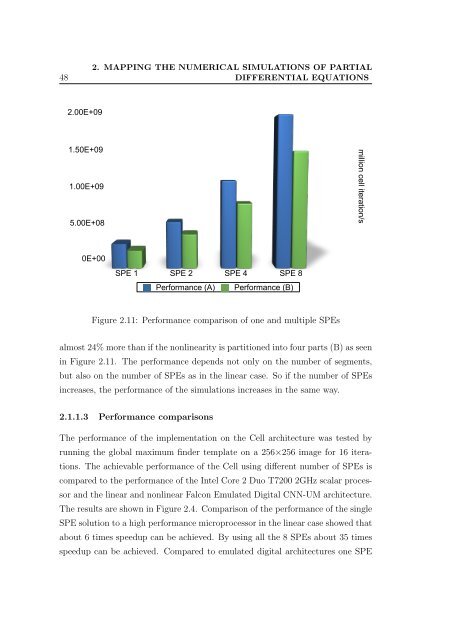PPKE ITK PhD and MPhil Thesis Classes
PPKE ITK PhD and MPhil Thesis Classes
PPKE ITK PhD and MPhil Thesis Classes
You also want an ePaper? Increase the reach of your titles
YUMPU automatically turns print PDFs into web optimized ePapers that Google loves.
48<br />
2. MAPPING THE NUMERICAL SIMULATIONS OF PARTIAL<br />
DIFFERENTIAL EQUATIONS<br />
2.00E+09<br />
1.50E+09<br />
1.00E+09<br />
5.00E+08<br />
million cell iteration/s<br />
0E+00<br />
SPE 1 SPE 2 SPE 4 SPE 8<br />
Performance (A)<br />
Performance (B)<br />
Figure 2.11: Performance comparison of one <strong>and</strong> multiple SPEs<br />
almost 24% more than if the nonlinearity is partitioned into four parts (B) as seen<br />
in Figure 2.11. The performance depends not only on the number of segments,<br />
but also on the number of SPEs as in the linear case. So if the number of SPEs<br />
increases, the performance of the simulations increases in the same way.<br />
2.1.1.3 Performance comparisons<br />
The performance of the implementation on the Cell architecture was tested by<br />
running the global maximum finder template on a 256×256 image for 16 iterations.<br />
The achievable performance of the Cell using different number of SPEs is<br />
compared to the performance of the Intel Core 2 Duo T7200 2GHz scalar processor<br />
<strong>and</strong> the linear <strong>and</strong> nonlinear Falcon Emulated Digital CNN-UM architecture.<br />
The results are shown in Figure 2.4. Comparison of the performance of the single<br />
SPE solution to a high performance microprocessor in the linear case showed that<br />
about 6 times speedup can be achieved. By using all the 8 SPEs about 35 times<br />
speedup can be achieved. Compared to emulated digital architectures one SPE






![optika tervezés [Kompatibilitási mód] - Ez itt...](https://img.yumpu.com/45881475/1/190x146/optika-tervezacs-kompatibilitasi-mad-ez-itt.jpg?quality=85)









